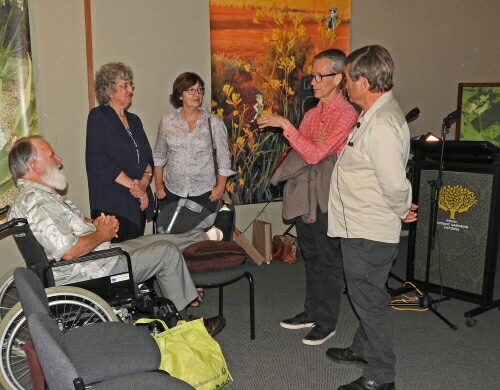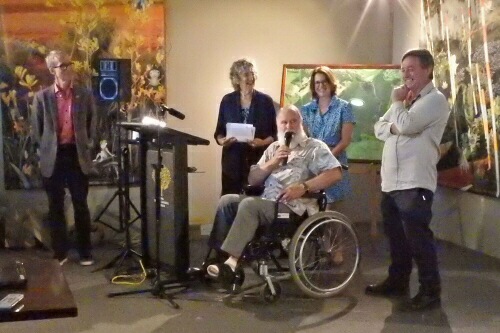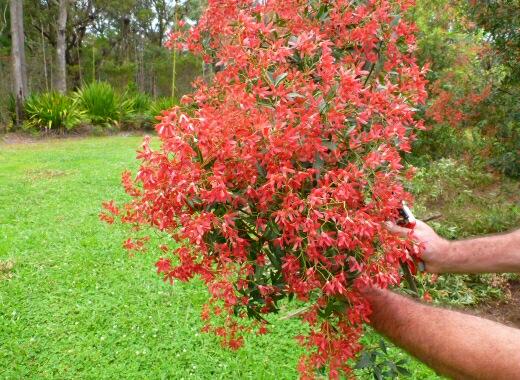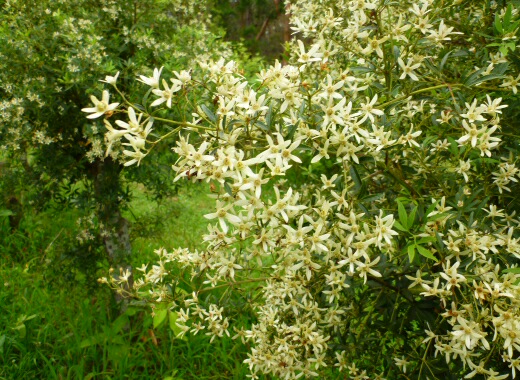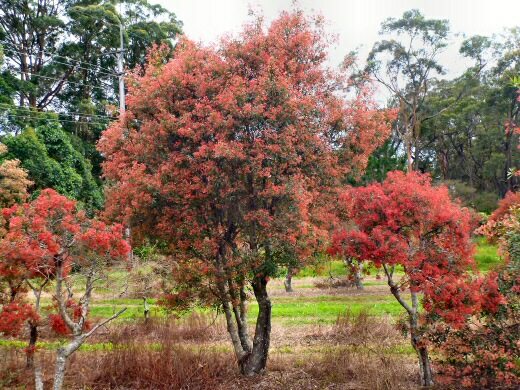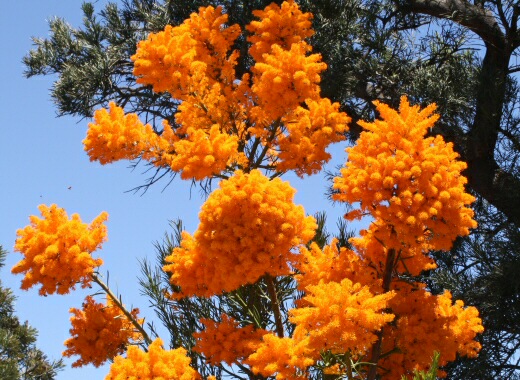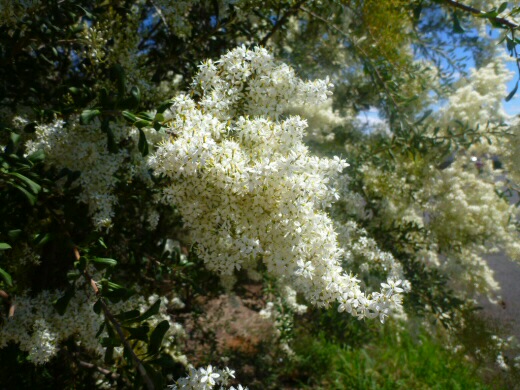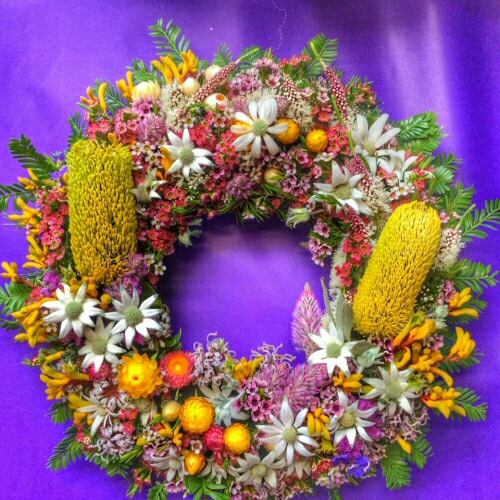THE AUSTRALIAN NATIVE GARDEN BOOK LAUNCH AT CRANBOURNE BOTANIC GARDENS
The Australian Garden at the Cranbourne Annexe of Royal Botanic Gardens Victoria is one of our horticultural gems, and is an amazing showcase for landscaping with native plants. So it was both an honour and privilege to launch The Australian Native Garden there, along with my co author AB Bishop. In addition to launching the book AB and I also presented a talk on how the Australian garden has changed over recent times. We also added our take on how Australian gardeners can use Australian plants to create environmentally friendly gardens into the future.
We were incredibly fortunate to have as MC the inimitable Professor Tim Entwistle, eminent scientist and botanical science communicator and Director of RBG Victoria. It got even better from my point of view to have my friends and mentors Rodger and Gwen Elliot to launch the book. We also had an esteemed audience of Australian plant professionals and enthusiasts and I would go so far as to say that the event was one of my career highlights to date.
My very sincere thanks to everyone who has contributed to the book along the way, and in particular to AB Bishop for her outstanding writing and inspiration. She is a champion of using the indigenous plants of your region as an underlying theme for those who wish to create an Australian garden that is home to the fauna of each part of Australia as well as its flora. I feel this is a good balance to my interests in Australian plant cultivars and the use of horticulturally improved forms of our native plants to achieve the best of all worlds in The Australian Native Garden.
All in all I feel the launch was a day to remember and the feedback I received from those who attended seemed to back that up. It was also a bonus to be able to visit the gardens there to see the wonderful progress that has been made as the gardens grow to maturity.
CHRISTMAS PLANTS OF AUSTRALIA
Wherever you are in Australia, christmas takes on a local hue, particularly with respect to the flowers we use to celebrate the annual festive season. I grew up on the NSW Central Coast and the floral magic was NSW Christmas Bush (Ceratopetalum gummiferum) and Christmas Bells (Blandfordia grandiflora).
The striking red display of flowers is created not by the petals of the NSW Christmas Bush, but by its calyx, which is made up of the sepals that surround the petals. The petals are white and have generally dropped off by November and after that the sepals gradually enlarge and turn red.
There are various shades of red, pink and even white sepals amongst the genetic variation in the species and there are named varieties such as Albery’s Red , Johanna’s Christmas and White Christmas if you want to be sure of the colour.
Flowering time varies in NSW Christmas Bush as well between different forms of the species and more importantly, among different locations, such that in Melbourne you are more likely to have peak colour in January, whilst it can be November on the NSW north coast or Brisbane. Cut flower growers in Australia and overseas have actually renamed this plant as “Festival Bush” to try and overcome the fact that it does not flower at christmas in all locations.
In Victoria the common name Christmas Bush is used for an entirely different plant, one of the native mint bushes, Prostanthera lasianthos in fact. This plant forms a small to large shrub depending on the habitat it is growing in and is surprisingly widespread in the wild, ranging from southern Qld down the east coast to Tasmania, but it is in Victoria that it is perhaps most widely used in cultivation for its habit of flowering around the Christmas period. The showy displays of flowers may be either pure white or suffused with pink or violet hues with attractive spots within the flower on closer inspection. This is a worthy plant for the garden and should be trimmed back behind the flowers as soon as it finishes flowering.
WA Xmas Bush Nuytsia floribunda
The Western Australian Christmas Bush is an entirely different type of plant to the Christmas Bushes of the other states. It is in fact a parasitic plant, which, in order for it to thrive, its roots must grow in contact with those of other plants in the bush such as wattles. There is not a great deal of research available on this subject and growing the WA Xmas bush in cultivation has proven rather difficult for gardeners, however, I have certainly seen it done so it is worth experimenting with if you can obtain a plant. The glowing orange-yellow flowers are a sight to behold when it is in full flower. It is a plant that flowers in response to bushfires which suggests to me that a good feed after it blooms will give the sort of growth response that would set up good flowering the following year.
Another interesting Christmas Bush is Bursaria spinosa which is celebrated as a Christmas bush particularly in South Australia and Tasmania. In other states it goes by the common name of sweet bursaria and native blackthorn, presumably because it flowers earlier than Christmas in northern localities. It is a very widespread large shrub to small tree that grows from north Qld right down the east coast to Tasmania and of course also across to South Australia. It is an extremely important habitat plant for small birds and is very adapatable and readily grown in the garden. As a member of the Pittosporum family it also shares a sweet fragrance with many of its botanical cousins. So it is a plant that I would highly recommend growing in your garden even if it does not flower at Christmas time.
So there you have it folks, wherever you are in our broad brown land it is time to deck the halls with boughs of Ceratopetalum, Bursaria, Protanthera and Nuytsia!
Merry Christmas and a very happy new year to you and your loved ones!
December Gardening To-do List
Summer has kicked in with plenty of dramatic weather, from heat waves to sleet to tornados all around the country in the last couple of weeks. It’s amazing how our awesome Aussie plants keep on growing in such conditions, delighting us with their unique forms , foliage and flowers and keeping our wildlife fed and sheltered.
As gardeners, we can help our flora and fauna along through summer conditions. Put out some water for the birds and insects to drink and splash in. Shallow bowls work best, and pop in a stone or some gravel to prevent drownings. Also change the water regularly to keep it clean and to stop mossies breeding. In windy and hot conditions, give plants a bit of extra water if possible, but make sure it gets down to the root zone, as a quick sprinkle on the soil surface will be wasted. New plants in particular need a bit of extra loving care until their roots get established.
I love my worm farms and the constant supply of worm juice they give. To stop your worms getting cooked, be sure to put them in a shady spot and give them a regular watering, which also helps to make that valuable worm wee. Placing a worm blanket on the surface of the top layer is great too, which stops them drying out. This can be bought from your nursery or hardware shop, or use an old cotton towel or sheet which will rot down over time.
For more hints, read my December Native Plant To-do List
Christmas Gift Time
Check out this amazing all Aussie native Christmas wreath from my lovely friends at The Wildflower Place at The Central Coast Highway Erina Heights NSW-
For lots of great last minute Christmas gift ideas, you can find plants for every garden from large to small, books (including The Australian Native Garden!), Australian products and flower arrangements at my favourite Australian native plant nurseries-
The Wildflower Place, Central Coast Highway, Erina, NSW
Newcastle Wildflower Nursery, 260 Lake Road, Glendale, NSW
Sydney Wildflower Nursery, Veno Street, Heathcote, NSW

